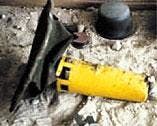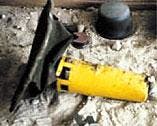Pipeline safety issues have become more prominent of late. An article in this issue updates the US pipeline industry’s status on some of those issues.
What propelled those issues to the forefront of public consciousness was a handful of recent accidents involving loss of life that garnered headlines across the US.
But most American consumers’ familiarity with pipeline safety concerns is limited to the inconveniences associated with gas mains rupturedusually harmlesslywhile some construction or maintenance crew digs up a road or a yard.
In other countries, the buried threat to oil and gas industry operations safety could be an unexploded bomb or armed land mine.
The US-led military operation in Afghanistan (and perhaps soon to come in Iraq) has prompted one leading explosive ordnance disposal (EOD) expert to speculate about earlier proposals to build pipelines across Afghanistan, once peace is fully restored to that beleaguered nation, and what contractors might encounter there.
EOD challenges
Robert Keeley, Asian Landmine Solutions director ([email protected]), cited his concerns over oil and gas activity in war-torn nations as he recalled some of the daunting EOD challenges encountered in the aftermath of the 1991 Persian Gulf war following the ouster of Iraq’s army from Kuwait.
Especially challenging was the task of disposing of unexploded ordnance (UXO) littering Kuwaiti oil fields set ablaze by the retreating Iraqi forces.
"Unexploded aircraft bombs and bomblets surrounded old Iraqi military positions, which also contained large stockpiles of abandoned and unused ammunition," Keeley recounted. "To make matters worse, large minefields fronted many of these defensive positions; some of the oil fires were right in the middle of these obstacles."
In trying to clear UXO and mine-littered areas for firefighters to dig lagoons for pumping water, the EOD teams had placed markers on fence posts to mark cleared areas. But the soot from burning oil quickly turned everything black. Sometimes the EOD teams had to stay at the cleared sites to point firefighting crews in the right direction or had to leave detailed maps of cleared areas at the Bechtel Corp. office overseeing the restoration effort on behalf of Kuwait Oil Co.
Keeley noted that the Kuwaiti oil fields demining effort finished on time, under budget, and without casualtieswhile citing some reports that more than 100 EOD personnel overall died in Kuwait after the war.
Complacency
Keeley worries that EOD work sometimes doesn’t get the attention and funding it deserves after a conflict, especially when humanitarian organizations focus on immediate aid for local populations.
Contractors often can find themselves faced with a minefield and associated liability but with no authority over demining.
"Some construction managers have…just assumed that their project wasn’t threatened, guessing that if the customer doesn’t mention it, the problem has already been solved," he noted. "Don’t assume that the local army [or outside military forces] will clear up the problem."
Guidance
He suggests:
- Demining be named a project line item well in advance.
- Contractual responsibilities be clarified regarding mine and UXO clearance.
- Contractors provide mine awareness training to all staff.
- Contractors should seek independent technical advice about mine clearance.
Lest we give the problem short shrift, Keeley warns that there are more than 60 countries reported as having a problem with landmine contamination. Countries such as Egypt still report problems with weapons left over from World War II.
"Unfortunately, in many cases, the problem is much worse than it was in Kuwait, where the war was short and where the Iraqis marked the minefields," Keeley said. "In many other countries, we don’t know where the mines actually are."



